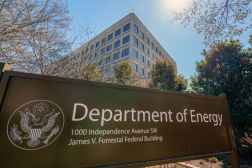Trump order calls for integrated AI platform led by Energy secretary, OSTP

Four months after the release of an artificial intelligence action plan, the White House on Monday unveiled its latest plans to embrace the emerging technology: an integrated AI platform that draws on federal scientific datasets and expertise from the public and private sectors.
President Donald Trump’s executive order to launch the administration’s “Genesis Mission” detailed what is being framed as a “dedicated, coordinated national effort to unleash a new age of AI‑accelerated innovation and discovery that can solve the most challenging problems of this century.”
The order says the platform will be used to train scientific foundation models and nurture new AI agents that will be tasked with testing new hypotheses, automating research workflows, and expediting scientific breakthroughs. That effort, per the order, will rely on the country’s top research-and-development resources, including U.S. scientists, universities, “pioneering American businesses,” national security sites, data repositories, existing infrastructure and the Department of Energy’s national laboratories.
Universities across the country have seen drastic cuts to federal funding, including the cancellation of myriad government contracts and grants. While Office of Science and Technology Policy Director Michael Kratsios has defended those cuts by saying DEI initiatives in federally funded research “degrade” science, his predecessor, Arati Prabhakar, said last month that the administration’s moves amounted to an “assault” on R&D.
“We’ve never seen anything like this, and it is extremely destructive to the science and technology enterprise today,” Prabhakar told an audience at Harvard’s Kennedy School, adding that “even more concerning to me is the damage it’s doing for Americans’ future because that public investment isn’t being made.”
Nevertheless, the new Trump order said this “pivotal moment” in the country’s history calls for a project “comparable in urgency and ambition to the Manhattan Project” during World War II that resulted in the atomic bomb and set the foundation for the DOE’s national labs.
“We will harness for the benefit of our Nation the revolution underway in computing, and build on decades of innovation in semiconductors and high-performance computing,” the order stated. “The Genesis Mission will dramatically accelerate scientific discovery, strengthen national security, secure energy dominance, enhance workforce productivity, and multiply the return on taxpayer investment into research and development, thereby furthering America’s technological dominance and global strategic leadership.”
The DOE secretary will take the lead on various implementation measures called out in the order, marshalling resources for the “secure, unified platform” — which the EO calls the American Science and Security Platform. The National Science Foundation, National Institute of Standards and Technology and National Institutes of Health also have key roles to play.
The assistant to the president for science and technology, meanwhile, is tasked with providing “general leadership of the Mission,” coordinating efforts across agencies and executive departments through the National Science and Technology Council.
The “operation” section of the order details components included as part of the platform: high-performance computing resources, including supercomputers at national labs; AI model and analysis frameworks, such as AI agents capable of design, evaluation, and automation; computational tools, like predictive and simulation models; domain-specific foundation models that cover a swath of scientific areas; experiential production tools; and secure access to datasets, including those that are “federally curated,” open source, or generated via DOE compute.
In the months ahead, the Energy secretary will be responsible for identifying computing, storage and network resources that will be used for the platform, while ensuring that the finished product aligns with federal cybersecurity standards. The secretary’s tasks also include looking for industry partners for computing support, selecting the initial data and model assets, and reviewing national laboratory capabilities.
The assistant to the president for science and technology will lead agency coordination and also work with the Federal Chief Data Officer and Chief AI Officer councils. The assistant also has responsibilities tied to the identification of data sources, coordinating R&D efforts, and teaming with the White House special adviser for AI and crypto on fostering partnerships that “preserve the security of Federal research assets and maximize public benefit.”
Kratsios, who currently holds the assistant for science and technology title, said in a statement Monday that Trump “is taking a revolutionary approach to scientific research, harnessing the power of AI to propel America into the Golden Age of Innovation.”
“The Genesis Mission,” he added, “connects world-class scientific data with the most advanced American AI to unlock breakthroughs in medicine, energy, materials science, and beyond.”






